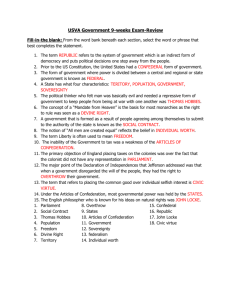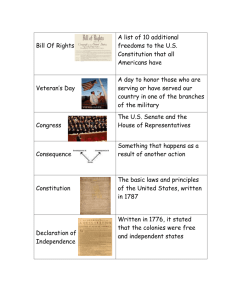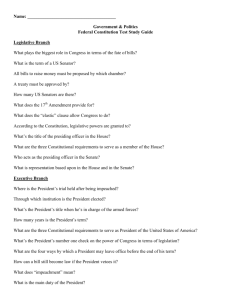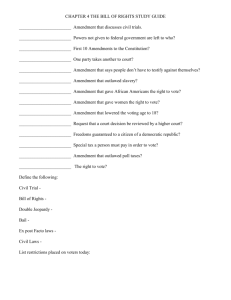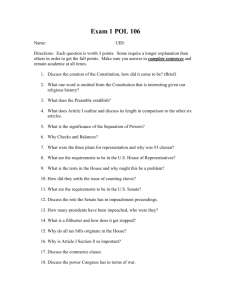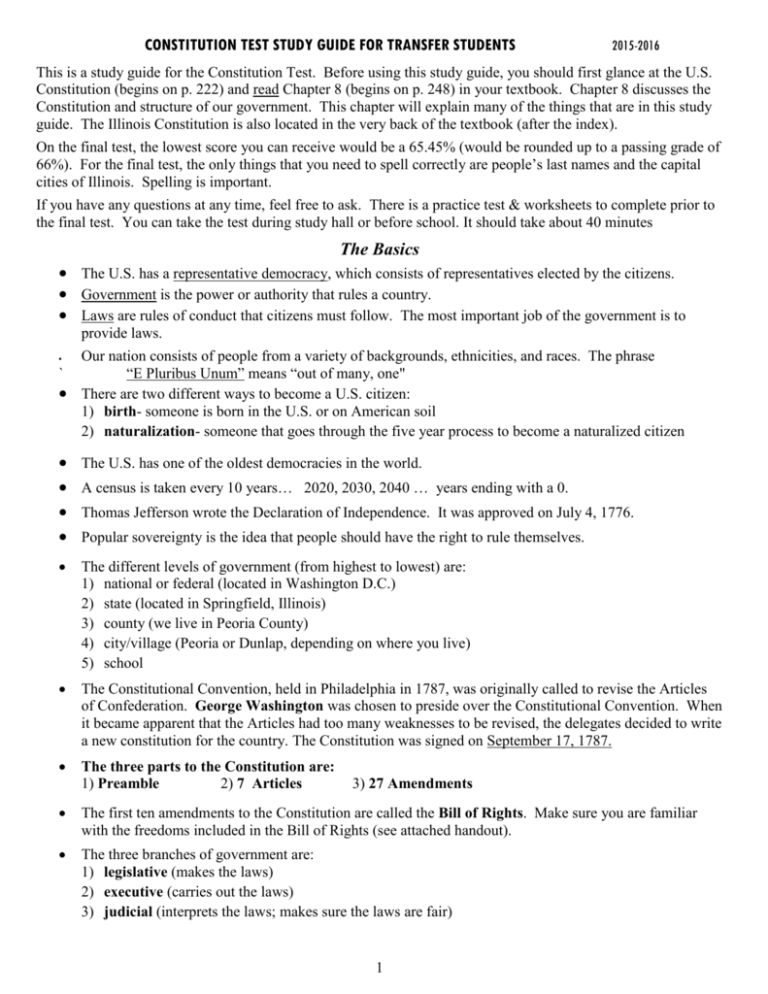
CONSTITUTION TEST STUDY GUIDE FOR TRANSFER STUDENTS
2015-2016
This is a study guide for the Constitution Test. Before using this study guide, you should first glance at the U.S.
Constitution (begins on p. 222) and read Chapter 8 (begins on p. 248) in your textbook. Chapter 8 discusses the
Constitution and structure of our government. This chapter will explain many of the things that are in this study
guide. The Illinois Constitution is also located in the very back of the textbook (after the index).
On the final test, the lowest score you can receive would be a 65.45% (would be rounded up to a passing grade of
66%). For the final test, the only things that you need to spell correctly are people’s last names and the capital
cities of Illinois. Spelling is important.
If you have any questions at any time, feel free to ask. There is a practice test & worksheets to complete prior to
the final test. You can take the test during study hall or before school. It should take about 40 minutes
The Basics
The U.S. has a representative democracy, which consists of representatives elected by the citizens.
Government is the power or authority that rules a country.
Laws are rules of conduct that citizens must follow. The most important job of the government is to
provide laws.
Our nation consists of people from a variety of backgrounds, ethnicities, and races. The phrase
`
“E Pluribus Unum” means “out of many, one"
There are two different ways to become a U.S. citizen:
1) birth- someone is born in the U.S. or on American soil
2) naturalization- someone that goes through the five year process to become a naturalized citizen
The U.S. has one of the oldest democracies in the world.
The different levels of government (from highest to lowest) are:
1) national or federal (located in Washington D.C.)
2) state (located in Springfield, Illinois)
3) county (we live in Peoria County)
4) city/village (Peoria or Dunlap, depending on where you live)
5) school
The Constitutional Convention, held in Philadelphia in 1787, was originally called to revise the Articles
of Confederation. George Washington was chosen to preside over the Constitutional Convention. When
it became apparent that the Articles had too many weaknesses to be revised, the delegates decided to write
a new constitution for the country. The Constitution was signed on September 17, 1787.
The three parts to the Constitution are:
1) Preamble
2) 7 Articles
A census is taken every 10 years… 2020, 2030, 2040 … years ending with a 0.
Thomas Jefferson wrote the Declaration of Independence. It was approved on July 4, 1776.
Popular sovereignty is the idea that people should have the right to rule themselves.
3) 27 Amendments
The first ten amendments to the Constitution are called the Bill of Rights. Make sure you are familiar
with the freedoms included in the Bill of Rights (see attached handout).
The three branches of government are:
1) legislative (makes the laws)
2) executive (carries out the laws)
3) judicial (interprets the laws; makes sure the laws are fair)
1
The Legislative Branch
Many people may change due to elections. We will learn these, so not to be confusing.
The legislative branch (Congress) has two houses. Congress makes the laws. The houses are called the
House of Representatives and the Senate. Only Congress can Declare War.
There are 435 members in the U.S. House of Representatives. Each state is allowed a certain amount of
representatives based on its population. The Constitution guarantees that each state will have at least
ONE representative. Illinois has 19 representatives.
The census, or a count of the people, happens every ten years. The census determines how many
representatives a state will have.
The requirements to be a member of the U.S. House of Representatives are:
1) 25 years old
2) a U.S. citizen for 7 years
3) a resident of the state in which elected
U.S. Representatives serve 2 year terms and there is no limit on the number of terms they can serve.
The leader of the House of Representatives is called the Speaker of the House. The Speaker is currently
John Boehner, (R- Ohio)
There are 19 Congressional districts in Illinois, we live in the 18th, and our U.S. Representative is Darin
LaHood.
The sole powers of the House of Reps. are:
1) start impeachment process
2) start money (or appropriations) bills
3) select the President if no candidate has a majority in the electoral college
There are 100 members in the Senate. Each state sends two individuals to the U.S. Senate.
U.S. Senators serve 6 year terms and there is no limit on the number of terms they can serve.
The requirements to be a member of the U.S. Senate are:
1) 30 years old
2) a U.S. citizen for 9 years
3) a resident of the state in which elected
The official leader of the Senate is the Vice-President. The Vice-President only casts a vote in the Senate
if there is a tie. The day-to-day leader of the Senate is called the President Pro Tempore. The President
Pro Tempore is currently Orrin Hatch.
Our two senators from Illinois are Dick Durbin and Mark Kirk.
The sole powers of the Senate are:
1) serve as the jury in the impeachment trial
2) approve presidential treaties
3) approve presidential appointments (who the president appoints to the Cabinet, Supreme Court, etc.)
4) select the Vice-President if no candidate has a majority in the electoral college
Make sure you know the following vocab words: sign, veto, pocket veto, override, filibuster, cloture,
appropriations
The president can do three things with a bill:
1) sign
2) veto
3) pocket veto
Congress can override a presidential veto with a 2/3 vote in both houses.
Only Congress has the power to declare war, but the President can order troops to go places and
commands the armed forces, Commander in Chief.
2
The Executive Branch
The first president of the U.S. was George Washington.
The President is the chief executive & Commander in Chief. The executive branch carries out laws.
The requirements to be President are:
1) 35 years old
2) born in the U.S.
3) a resident of the U.S. for 14 years
The President serves a term of 4 years and can serve no more than 2 terms.
If something happens to the President, there is an order of succession stated in the Constitution. The
order of succession is as follows: These may change mid year due to elections. Learn these please.
1) President- Barrack Obama
2) Vice-President- Joe Biden
3) Speaker of the House- John Boehner
4) President Pro Tempore- Orrin Hatch
5) Secretary of State- John Kerry
The President has the power to grant pardons (declaration of forgiveness and freedom from punishment),
reprieves (an order to delay a person’s punishment), or amnesty (similar to a pardon, but applies to a
group of people rather than an individual).
The President can make a treaty with another country, but the Senate must approve it.
The President may appoint people to his Cabinet (a group of department heads,
Vice-President, and other officials). The Senate must approve these nominations. The role of the Cabinet
is to advise the President.
The Cabinet is not mentioned anywhere in the Constitution. Washington decided to have a Cabinet
during his presidency.
There are currently 15 executive departments (Department of State, Treasury, Defense, Justice, Interior,
Agriculture, Commerce, Labor, Health & Human Services, Housing & Urban Development,
Transportation, Energy, Education, Veterans Affairs, and Homeland Security). Know there are 15.
All of the department heads are called secretary. For example, the head of the Department of Defense is
called the “Secretary of Defense.” The current Secretary of Defense is Chuck Hagel. The exception to
this is the Department of Justice. The head of the Department of Justice is called the Attorney General.
The current Attorney General is Loretta Lynch.
The National Security Council aids the President in life and death decisions about US safety.
3
The Judicial Branch
The job of the judicial branch is to interpret laws.
The three levels of federal courts (from highest to lowest) are:
1) Supreme
2.) appellate or court of appeals
3.) district
Most of the work of federal courts takes place in the district courts. District
courts are the only federal courts that have jury trials.
There is no appeal once a case reaches the Supreme Court.
The two types of court cases are:
1) criminal (cases in which juries decide whether people have committed crimes)
2) civil (cases in which two sides disagree over an issue; usually for money, property, injuries, or
damages)
U.S. Supreme Court justices are appointed by the President, approved by the Senate, and serve for life.
There are a total of nine U.S. Supreme Court justices (1 Chief Justice and 8 Associate Justices). In the
Constitution, there are no requirements to be on the U.S. Supreme Court.
The Chief Justice of the U.S. Supreme Court is John Roberts.
The first female U.S. Supreme Court Justice was Sandra Day O’Connor and Thurgood Marshall was
first African American Supreme Court Justice.
Judicial review is the power to review any law to see if it agrees with the Constitution
A subpoena is a court order, which requires someone to appear in court.
A marshal is the individual who is responsible for arresting suspects, delivering defendants to court, and
serving subpoenas.
A magistrate is the individual who is responsible for issuing court orders and determining whether there is
enough evidence to bring a case to trial.
United States Flag
The U.S. flag first originated during the American Revolution.
The blue field on the flag is called the union.
There are seven red stripes and six white stripes on the flag. These stripes represent the original 13
colonies.
The flag has 50 stars which represent the states.
The two proper ways to destroy the flag are to burn or bury it.
4
Illinois Government
State government is very similar to national government. One of the most difficult parts of studying for
the Constitution Test is that it is sometimes easy to confuse what you have already learned about national
government with what you are about to learn about state government. Review, review, and review some
more so this doesn’t happen to you!
State government has the same three branches of government: legislative, executive, and judicial.
In Illinois, the executive branch is headed by the Governor. The current governor of Illinois is Bruce
Rauner. Like the President, the governor can issue pardons and can sign or veto state legislation. The
governor is the chief executive of Illinois.
In Illinois, the legislative branch consists of a two-house legislature called the General Assembly. The
General Assembly has two houses called the House of Representatives and the Senate.
There are 118 Representative districts in Illinois, we live in the 73rd district, our State Representative is
David Leitch.
There are 59 Legislative districts in Illinois, we live in the 37th district, and our State Senator is VACANT
New person to be appointed- was LaHood-.
There are 19 Congressional districts in Illinois, we live in the 18th, and our U.S. Representative is Darin
LaHood. (This is the representative to the House of Representatives in Washington DC.)
Illinois was the 21st state admitted into the union on December 3, 1818.
Illinois has changed capitals throughout the years. The three capitals of Illinois (in order) are:
1) Kaskaskia
2.) Vandalia
3.) Springfield (current)
You must be 18 to vote in Illinois or in any state.
The Illinois state symbols are as follows:
state animal- white-tailed deer
state slogan/motto- “Land of Lincoln”
state insect- monarch butterfly
state bird- cardinal
state flower- violet
state mineral- fluorite
state tree – white oak
Illinois Fact Sheet
Elected Illinois Officials
Governor Bruce Rauner
Lieutenant Governor Shelia Simon
Attorney General Lisa Madigan
Secretary of State Jesse White
Comptroller Leslie Munger
Treasurer Michael Frerichs
Shadrach Bond became the first governor of Illinois in 1818.
There are 102 counties in Illinois. We live in Peoria County. Cook County is the biggest (Chicago) and Pope
County is the smallest, which includes Shawnee National Forest.
5
Vocabulary and Notes
Both the House of Reps. and the Senate debate on their versions of the bill. Senators sometimes
engage in a delay tactic known as filibuster. One or more senators may kill a bill by talking until the
bill's sponsor withdraws it. The only way to prevent a filibuster is to take a vote on whether or not to
have cloture. Cloture limits a senator to one hour of debate
After a bill has been debated in the House of Reps. or the Senate, it is brought to a vote. There are
three ways to vote: 1. voice vote
2. standing vote
3. roll-call vote
When the bill is sent to the President, he can do three things with it:
1. sign (approve it)
2. veto (reject it)
3. pocket veto
Congress can override (defeat) a presidential veto with a 2/3 vote in both houses.
Vocabulary
1. checks and balances- a system where each branch can limit the power of another branch
2. census- a count of the people
3. veto- to reject
4. representative democracy- a democracy in which citizens elect others to govern
5. quota- a numerical limit
6. national government- highest level of government in the US
7. treaty- a formal agreement with another country
8. laws- rules of conduct
9. appropriation- money
10. pardon- presidential order to free someone from punishment
11. slander- saying something false about someone to harm their reputation
12. franking privilege- postage free mail for job related reasons
13. treason- giving military secrets to enemies
How a Bill becomes a Law
1. A bill may be introduced in either the Senate or House of Representatives by a member.
2. It is referred to a committee for a hearing. The committee studies the bill and may hold public
hearings on it. It can then pass, reject or take no action on the bill.
3. The committee report on the passed bill is read in open session of the House or Senate, and the bill
is then referred to the Rules Committee.
4. The Rules Committee can either place the bill on the second reading of the calendar for debate
before the entire body, or take no action.
5. At the second reading, a bill is subject to debate and amendment before being placed on the third
reading calendar for final passage.
6. After passing one house, the bill goes through the same procedure in the other house.
7. When the bill is accepted in both houses, it is signed by the respective leaders and sent to the
president. The president signs the bill into law or may veto all or part of it. If Congress is in
session and the president fails to sign the bill, it becomes law without his signature. If Congress
is not in session, it is a pocket veto.
8. All tax bills for raising revenue (money) shall originate in the House of Representatives; but the
Senate may propose or concur with amendments as on other bills.
6
The Bill of Rights is in the US history book with the US Constitution, pp.222-245. A few will be on the test.
Bill of Rights (Amendments 1-10) and Amendments 11-27
Amendment I [Religion, Speech, Press, Assembly, Petition (1791)]
Amendment II [Right to Bear Arms (1791)]
Amendment III [No Quartering of Troops (1791)]
Amendment IV [Illegal Search and Seizure (1791)]
Amendment V [Grand Jury, No Double Jeopardy, Self-Incrimination, Due Process (1791)]
Amendment VI [Criminal Prosecutions - Jury Trial, Right to Confront and to Counsel (1791)]
Amendment VII [Guarantees the right to a jury trial in civil cases - Jury Trial (1791)]
Amendment VIII [NO Excess Bail or Fines, Cruel and Unusual Punishment (1791)]
Amendment IX [Guarantees individual rights-unwritten rights can not be taken away
Non-Enumerated Rights (1791)]
Amendment X [Any right not given to the national gov.'t . is a state right
Rights Reserved to States (1791)]
Amendment XI [Suits Against a State (1795)]
Amendment XII [Revised the way the President and Vice President are election (1804)]
Amendment XIII [Abolition of Slavery (1865)]
Amendment XIV [Privileges and Immunities, Due Process, Equal Protection, Apportionment of
Representatives, Civil War Disqualification and Debt (1868)]
Amendment XV [Rights Not to Be Denied Based on Race (1870)]
Amendment XVI [Income Tax (1913)]
Amendment XVII [Direct Election of Senators (1913)
Amendment XVIII [Prohibition (1919)]
Amendment XIX [Women's Right to Vote (1920)
Amendment XX [Presidential Term and Succession (1933)]
Amendment XXI [Repeal of Prohibition (1933)]
Amendment XXII [Two Term Limit on President (1951)]
Amendment XXIII [Presidential Vote in D.C. (1961)]
Amendment XXIV [Poll Tax (1964)]
Amendment XXV [Presidential Succession (1967)]
Amendment XXVI [Right to Vote at Age 18 (1971)]
Amendment XXVII [Delays Congressional pay raises until next term (1992)]
7





